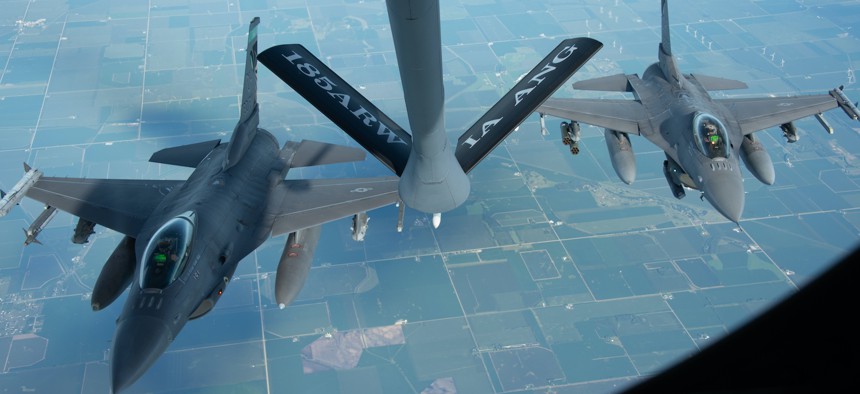
Two U.S. Air Force F-16 Fighting Falcons of the Ohio Air National Guard’s 180th Fighter Wing fly behind a U.S. Air Force KC-135 Stratotanker of the Iowa Air National Guard’s 185th Air Refueling Wing over Iowa, Aug. 11, 2022. U.S. Air Force / Airman 1st Class Tylon Chapman
How Self-Flying F-16s Will Enable Future Fighter Drones
The Air Force’s Venom project aims to use test data to train an AI engine that can be widely used.
The Air Force is rigging F-16s to fly autonomously, but that’s not the main point of automating one of the service’s most numerous fighter jets, the commander of the Air Force Test Center said Monday. Instead, the Venom project aims to refine an AI engine to fly a wide variety of today’s and tomorrow’s aircraft.
Venom, in turn, is part of the years-long push to develop autonomous aircraft that can work alongside crewed aircraft or operate autonomously, Maj. Gen. Evan Dertian said at a Mitchell Institute event.
It’s not even the first time that the Air Force has built an F-16 drone. The Have Raider II program achieved that five years ago. It was followed by other autonomous flight efforts such as the XQ-58 Valkyrie and the X-62 Vista, which is basically an F-16 modified to test and train AI software.
“The Vista aircraft is great for the control [testing].We kind of have the safety wrapper to develop autonomy,” said Dertien. “What we don't have on that aircraft is a lot of sensors. So by getting in on the Venom aircraft, you now have…radar; you have electronic warning; you have all those things where now you can expand your autonomy algorithm to react to the inputs. It's getting to make decisions for himself. It's kind of the next evolution into scaling up what autonomy can do.”
The goal is not a perfect pilotless F-16 but rather to refine an autonomy software engine that could be useful across aircraft and to develop concepts for operating autonomous aircraft along or with other aircraft.
The Air Force has solved some aspects of autonomy in flight. They’re now focused on discovering how autonomous systems fit into future warplanes, particularly for contested environments. “What we've done for our concept of operations and consequent employment is build in the ability to both have a human in and on the loop and then also—when that doesn't happen because of the contested electromagnetic spectrum that we anticipate—we still have built the capabilities from the mission-planning perspective, from the rules of engagement, and from the autonomy perspective so that these aircraft can still be effective in the fight,” said Maj. Gen. R. Scott Jobe, Air Combat Command’s director of plans, programs, and requirements.
Part of Venom is learning to collect data from the aircraft, said Maj. Gen. Heather Pringle, who leads the Air Force Research Laboratory.
That data will help accelerate the Air Force’s Collaborative Combat Aircraft program, a wide-ranging initiative to test new autonomous and human-machine air team concepts. Said Dertien: “The goal is to have one core autonomy engine so we're not investing in different acquisition programs for the autonomy portion” of that program.
Brig. Gen. Dale White, the Air Force’s program executive officer for fighters and advanced aircraft, said “the idea is that our autonomy will be platform-agnostic is really critically important because we're not going to re-create the wheel every time we go to a different platform…The autonomy will be something that will be easily integrated.”
This year, the Air Force is requesting $49.7 million for the Venom project. Much of that will be spent on getting the F-16s ready for autonomous testing and preparing test ranges at Edwards Air Force base.
Audrey Decker contributed to this post.




